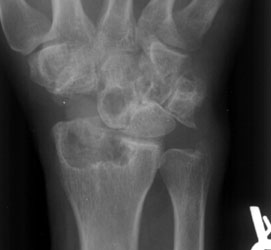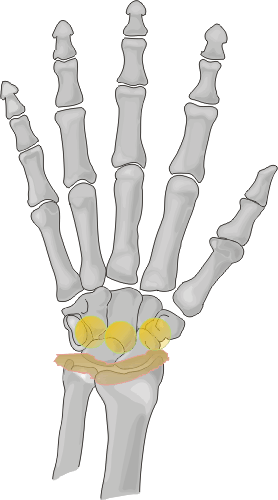 Silastic arthropathy is a complication usually of silicone implants
used in orthopedic surgery for joint reconstruction. This process of particle
synovitis can also be caused by introduction of other foreign materials used
in prosthetic hardware such as metal, polyethylene, polymethylmethacrylate
cement, etc.
Silastic arthropathy is a complication usually of silicone implants
used in orthopedic surgery for joint reconstruction. This process of particle
synovitis can also be caused by introduction of other foreign materials used
in prosthetic hardware such as metal, polyethylene, polymethylmethacrylate
cement, etc.
Distribution:
Silastic arthropathy can occur at any of the bones where there is a prosthetic
implant in place. However, involvement at the hand and wrist is most common
at the carpal bones, a location that is more susceptible to stress forces.
In decreasing order of frequency, scaphoid, lunate and scapholunate implants
are the most commonly affected carpal prostheses.
Radiographic Appearance:
At the site of the implant, an inflammatory process occurs in response to
the foreign particles, which are sloughed off of the implant. This leads to
erosion of bone and articular cartilage, and intraosseous cystic changes.
There can also be soft tissue swelling and calcifications in the immediate
area. Fractures and destructive changes of the prosthesis are sometimes present.
Differential Diagnosis:
Once a prosthetic implant is visualized in conjunction with the above
mentioned radiographic findings, the diagnosis usually becomes apparent. Nevertheless,
considerations in the differential diagnosis may include amyloidosis, pigmented
villonodular synovitis, and infections caused by fungus or tuberculosis.






